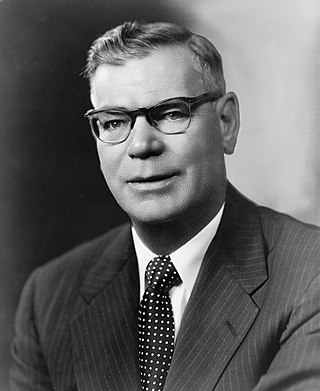
Edward Lewis "Bob" Bartlett, was an American politician and a member of the Democratic Party. He served as a U.S. Senator. A key fighter for Alaska statehood, Bartlett served as the Secretary of Alaska Territory from 1939 to 1945, in Congress from 1945 to 1959 as a Delegate, and from 1959 until his death in 1968 as a U.S. senator. He was opposed to U.S. involvement in Vietnam, along with his fellow Senator Ernest Gruening, and also worked to warn people about the dangers of radiation. Many acts bear his name, including a major law known as the Bartlett Act, mandating handicap access in all federally-funded buildings.

Ernest Henry Gruening was an American journalist and politician. A member of the Democratic Party, Gruening was the governor of the Alaska Territory from 1939 until 1953, and a United States Senator from Alaska from 1959 until 1969.

The Alaska State Capitol is the building that hosts the Alaska Legislature and the offices of the Governor of Alaska and Lieutenant Governor of Alaska. Located in the state's capital, Juneau, the building was opened on February 14, 1931, as a federal building. After Alaska gained statehood in 1959, the building became home to the Alaska Legislature and has retained the function ever since.

The Alaska Statehood Act was a legislative act introduced by Delegate E. L. "Bob" Bartlett and signed by President Dwight D. Eisenhower on July 7, 1958. Through it, Alaska became the 49th U.S. state on January 3, 1959. The law was the culmination of a multi-decade effort by many prominent Alaskans, including Bartlett, Ernest Gruening, Bill Egan, Bob Atwood, and Ted Stevens.

Frank Hinman Waskey was a delegate from the District of Alaska to the United States House of Representatives from 1906 to 1907.

Edmund Burke Riley Jr. was an American Democratic legislator, lawyer and public official on territorial, state and national levels. He served as the Secretary of Alaska Territory from 1952-1953 under Governor Ernest Gruening. He was a signer of the Alaska Constitution, elected as one of seven at-large delegates from the First Division.
The 1965 March against the Vietnam War was an anti-Vietnam War protest that took place in Washington, D.C., on 17 April 1965.

The Hall of Columns is a more than 100-foot-long (30 m) hallway lined with 28 fluted columns in the south wing extension of the United States Capitol in Washington, D.C. It is also the gallery for 18 statues of the National Statuary Hall Collection.
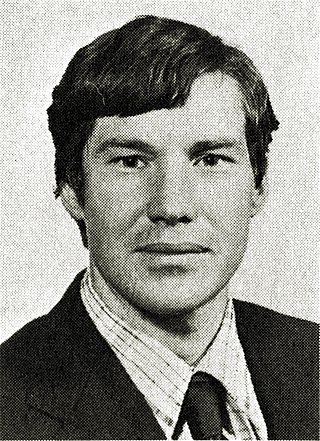
Clark S. Gruening is an attorney and Democratic Party politician from the U.S. state of Alaska. He is chiefly known as the second of three persons to defeat the incumbent holder of Alaska's Class 3 United States Senate seat in the primary election.

The Alaska Territorial Guard (ATG), more commonly known as the Eskimo Scouts, was a military reserve force component of the US Army, organized in 1942 in response to attacks on United States soil in Hawaii and occupation of parts of Alaska by Japan during World War II. The ATG operated until 1947. 6,368 volunteers who served without pay were enrolled from 107 communities throughout Alaska in addition to a paid staff of 21, according to an official roster. The ATG brought together for the first time into a joint effort members of these ethnic groups: Aleut, Athabaskan, White, Inupiaq, Haida, Tlingit, Tsimshian, Yupik, and most likely others. In later years, all members of some native units scored expert sharpshooter rankings. Among the 27 or more women members were at least one whose riflery skills exceeded the men. The ages of members at enrollment ranged from 80 years old to as young as twelve (both extremes occurring mostly in sparsely populated areas). As volunteers, the Alaska Territorial Guard members were those who were too young or too old to be eligible for conscription during the World War II.

The 1980 United States Senate election in Alaska was held on November 4, 1980. Incumbent Democratic United States Senator Mike Gravel ran for a third term in the United States Senate, but lost in the Democratic primary to Clark Gruening, a former state representative who was the grandson of Ernest Gruening, whom Gravel had defeated twelve years prior in an election for the same seat. Gruening later went on to lose the general election to Republican nominee Frank Murkowski, a banker.
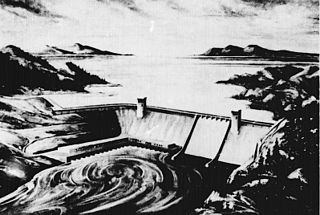
The Rampart Dam or Rampart Canyon Dam was a project proposed in 1954 by the U.S. Army Corps of Engineers to dam the Yukon River in Alaska for hydroelectric power. The project was planned for Rampart Canyon just 31 miles (50 km) southwest of the village of Rampart, Alaska, about 105 miles (169 km) west-northwest of Fairbanks.

The 1968 United States Senate election in Alaska took place on November 5, 1968. Incumbent Democratic U.S. Senator Ernest Gruening ran for a second full term in office but finished behind Speaker of the Alaska House of Representatives Mike Gravel in the Democratic primary. Gruening launched a write-in bid for the seat in the general election, but finished third to Gravel and Republican former Anchorage mayor Elmer Rasmuson.

The 1962 United States Senate election in Alaska took place on November 6, 1962. Incumbent Democratic U.S. Senator Ernest Gruening ran for a second term in office and defeated Republican nominee, Anchorage lawyer, former Interior Solicitor & former U.S. Attorney Ted Stevens.

The 1958 United States Senate elections in Alaska were held November 25, 1958. The elections were held in anticipation of Alaska's admission as the forty-ninth state in the union, effective January 3, 1959. The state held two simultaneous elections to determine their first senators.
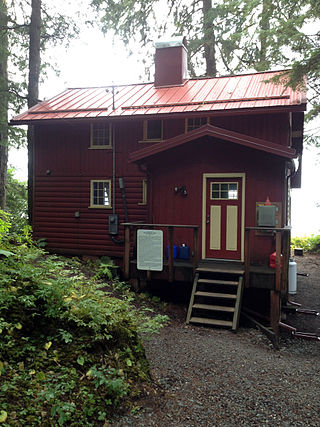
The Ernest Gruening Cabin is a historic rural cabin in Juneau, Alaska, United States, and the centerpiece of Ernest Gruening State Historical Park. It is a 1+1⁄2-story wood-frame structure located 26 miles (42 km) north of the city on the Glacier Highway. It is the only building associated with the life of Ernest Gruening, governor of the Alaska Territory 1939–53, other than the Alaska Governor's Mansion. The cabin was built on land Gruening leased from the United States Forest Service, and was built by local laborers including Gruening's son Hunt. The cabin measures 24 feet (7.3 m) by 28 feet (8.5 m), with a gable roof and a large fieldstone chimney. Its exterior is finished in shiplap siding milled to resemble unfinished logs. The interior consists of a single large chamber, with a circular stairway leading to a sleeping loft above. The kitchen area is set apart from the rest of the space by different flooring, an alteration by Gruening's grandson. The property is now a state historic site.
Norman Ray "Doc" Walker was a Canadian-born American pharmacist and politician, best known as the longest-serving member of Alaska's territorial legislature. Born in Regina, Saskatchewan, Walker emigrated to the United States as a youth, later serving in the United States Army and attending Washington State University. He was a pharmacist in Seattle, Washington and then moved to Ketchikan, Alaska and owned the Walker-Broderick House. Walker served as mayor of Ketchikan from 1930 to 1932 and then served in the Alaska Territorial Senate from 1933 until 1947. He lost reelection to his Senate seat in 1948 after feuding with territorial governor Ernest Gruening over Gruening's efforts to overhaul the territory's tax structure. Walker was also head of the Alaska Territorial Pharmacy Board.

Dorothy Gruening née Smith (1888–1979) was known for her social activism. Specifically, she was the general secretary of the Salem, Massachusetts Young Women's Association, and was active in the Women's International League for Peace and Freedom.
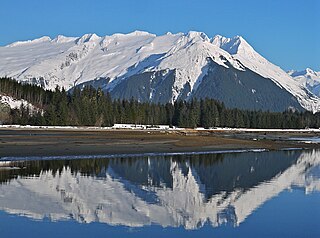
Mount Ernest Gruening is a 6,015+ ft glaciated mountain summit located in the Boundary Ranges of the Coast Mountains, in the U.S. state of Alaska. The long ridge-like mountain is situated between the Herbert Glacier and Eagle Glacier at the west edge of the Juneau Icefield, 20 mi (32 km) northwest of Juneau, Alaska, and 8 mi (13 km) east of Favorite Channel, on land managed by Tongass National Forest. Although modest in elevation, relief is significant since the east face of the mountain rises over 3,500 feet above the Herbert Glacier in less than one mile, and the west aspect rises 5,800 feet above the Eagle River valley in two miles.
In the history of discrimination in the United States, the Alaska Equal Rights Act of 1945 was the first state or territorial anti-discrimination law enacted in the United States in the 20th century. The law, signed on February 16, 1945, prevents and criminalizes discrimination against individuals in public areas based on race. The law came about after Alaska Natives fought against segregation and other forms of discrimination in Alaska.

















